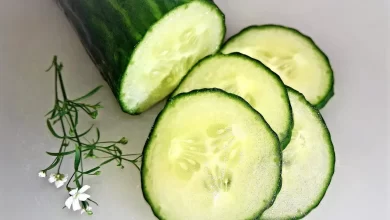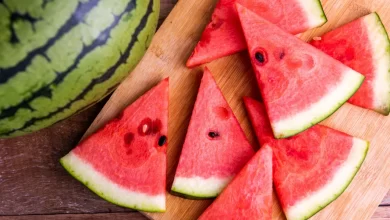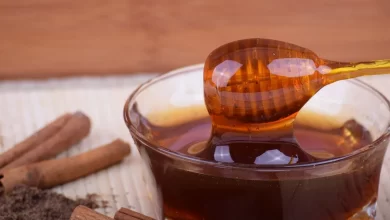Bananas are one of the most healthy and popular fruits. It is variable in color, size, and firmness but usually is elongated and curved. It is soft flesh rich in starch and covered with a rind which may be yellow, red, purple, green, or brown when it gets fully ripe. Almost all modern edible seedless bananas come from two wild species, of which the scientific names are Musa acuminata and Musa balbisiana.
- The name banana is derived from the Arabic word ‘banana which means finger.
- The earliest written references of this fruit were discovered in the Sanskrit language dating back to the year 500 BC.
- Bananas share about 60% of the same DNA as Humans.
- Bananas will float in the water as water is denser than the bananas.
- Bananas grow, pointing upwards.
- Bananas are curved because of the sun and so that they can retrieve sunlight. Bananas go through a process called negative geotropism, which means the fruit grows away from the ground instead of growing towards it; hence, it is negative geotropism.
- Bananas are not refrigerated because these are tropical fruits and thus have no defense against the cold in their cell walls. These become ruptured by cold temperature causing the fruit’s digestive enzymes to leak out of the cells, which causes the rind to turn black.
- Bananas are seedless because of the fact that the parent banana tree is triploid (3X chromosome sets) even though pollination is normal.
- There are over 1000 different varieties of bananas grown worldwide, which are Subdivided into 50 main groups.
- The banana tree and its yield is not a true fruit in real it is a giant herb, and the banana is actually its berry.
- A single banana is referred to as a finger, while a bunch of bananas is called a hand.
- To grow a banana plant, its shoots should be planted in the soil.
- A banana plant produces only one bunch or “hand” of bananas in its lifetime, but that bunch may have between 100 to 400 bananas.
- The banana tree takes around nine months to grow and produce fruit. Once the fruit is harvested, the banana trees die.
- Despite having a phallic shape, the banana is sterile, and no fertilization takes place in the banana flowers.
- In one kg of bananas, on average, there are seven bananas fingers.
- There are bananas known as the “Red banana,” and these are maroon to dark purple when fully ripe.
- Bananas the most popular fruit in Australia, with 5 million bananas are eaten in the country every day. Annually an Australian eats about 15 kg of bananas, which comes to be 27 meters of banana.
- India is the largest producer of bananas, with a production of 30.5 million tonnes of bananas produced in the year 2017. The second-biggest producer is China with 11.2 million tonnes.
- Juicing bananas produce a puree rather than a juice, so it is often more effective to blend them instead.
- Banana contains a high level of potassium and pectin, which is a form of fiber. They also contain magnesium, Vitamin C and B6.
- Due to the presence of potassium, it is good for your heart.
- Bananas are also good for the skin, aid digestion, and help beat gastrointestinal issues.
- A banana allergy is often connected to latex allergy. This is because some of the proteins that are present in the rubber trees that produce latex are known to cause allergies, and they are very much similar to the proteins found in some nuts and fruits like avocados and chestnuts.
- Bananas are radioactive this is because they are rich in potassium, of which the chemical symbol is K, and a very small fraction of that naturally occurring potassium is radioactive.
- The radiation from the fruit measures out as 3,520 picocuries per kg– that’s high enough to set off the more sensitive type of radiation alarms. If you eat one banana per day, you will receive a dose of 2.6 mrem per year.
- Deep, rich loamy soil with a pH between 6.5 – 7.5 is most preferred and suitable for banana cultivation. To grow the fruit, the soil should have good drainage, adequate fertility, and moisture.
- Banana oils from the skin of the fruit are very much beneficial in mosquito bites itching. This is because the sugars in the banana peel helps to draw the fluids of itchy mosquito bites.
- Bananas contain a high amount of starch when they are green. When they turn yellow, the starch in them converts to sugars.
- The world recorded of eating most bananas is achieved by Patrick Bertoletti of the United States. He peeled and ate eight bananas in one minute.
Nutrition Facts of Banana
Here are the nutrition facts about for one Banana.
- Energy (calories): 105
- Carbohydrate: 27, including 14.4 g of sugar
- Fiber3.1 grams
- Protein: 1.3 grams
- Magnesium: 31.9 mg
- Phosphorus: 26 mg
- Potassium: 422 mg
- Selenium: 1.9 mcg
- Choline: 11.6 mg
- Vitamin C: 10.3 mg
- Folate: 23.6 (mcg DFE)
- Beta carotene: 30.7(mcg)
- Alpha carotene (mcg): 29.5 (mcg)
References
- Britannica-Banana Plant
- Wikipedia-Banana
- Businessinsider.com(banana share same DNA as humans)
- medicalnewstoday.com






